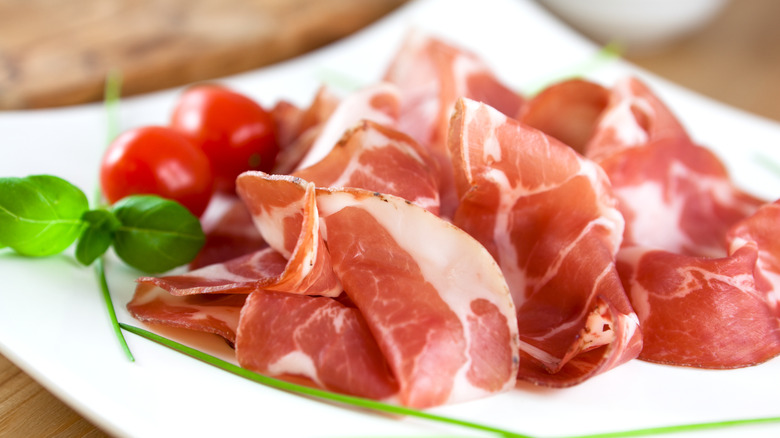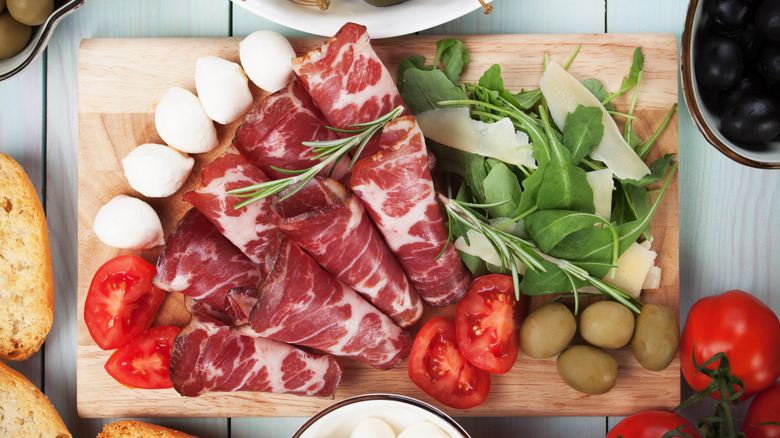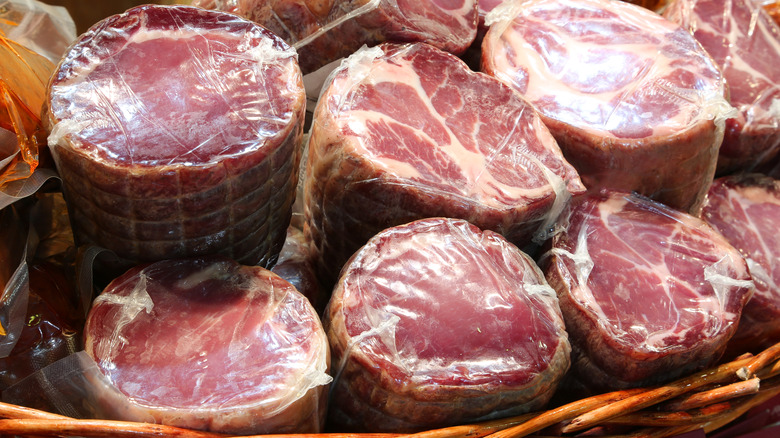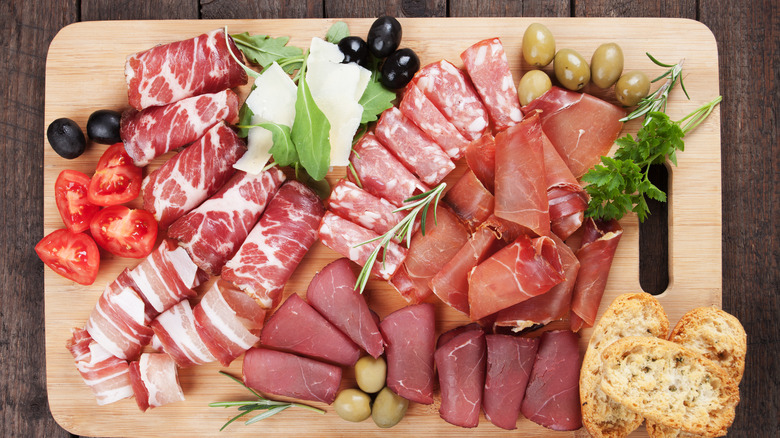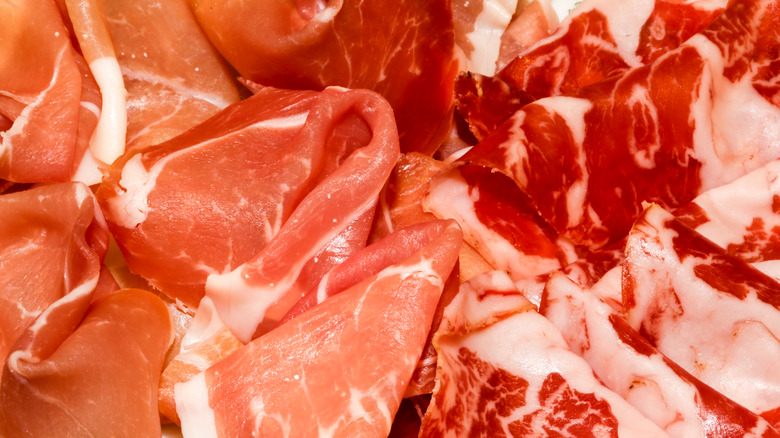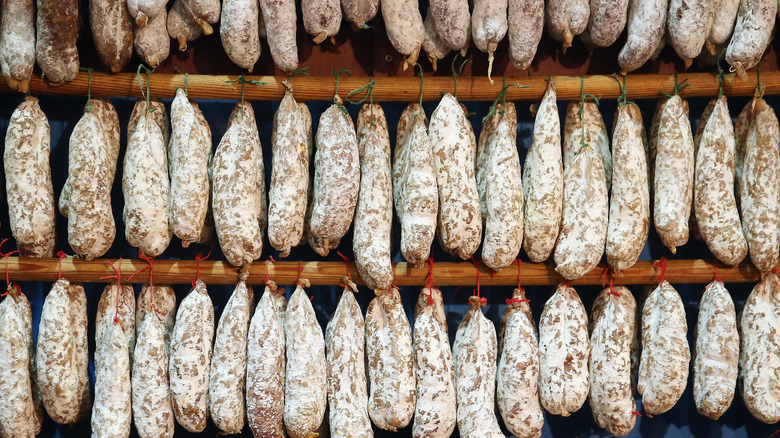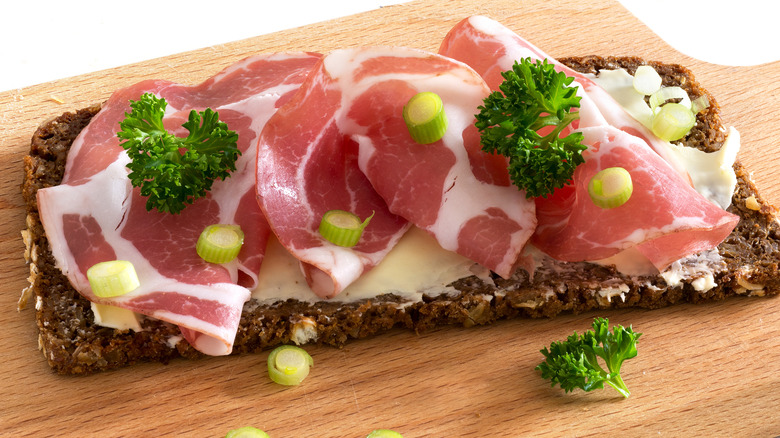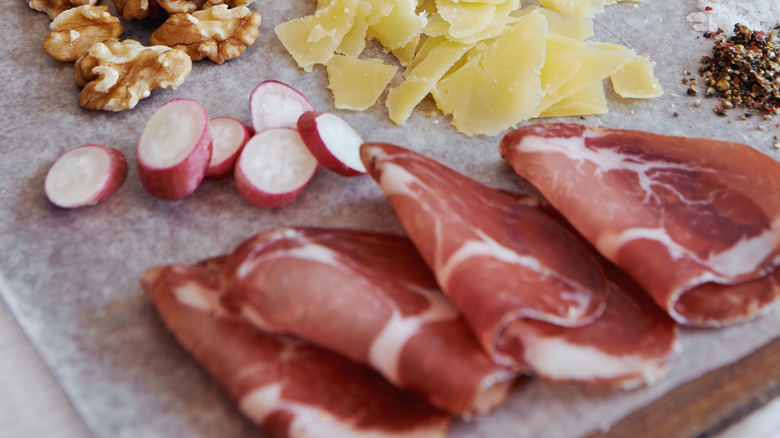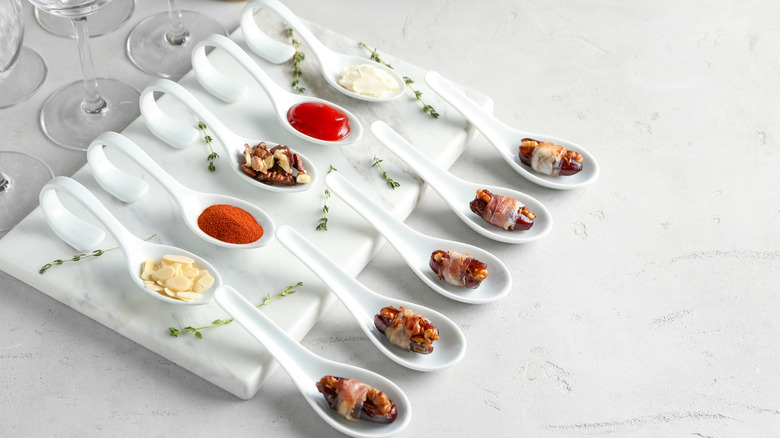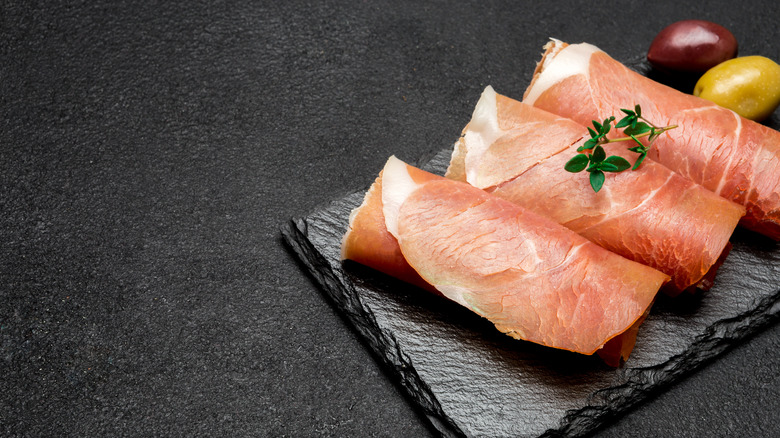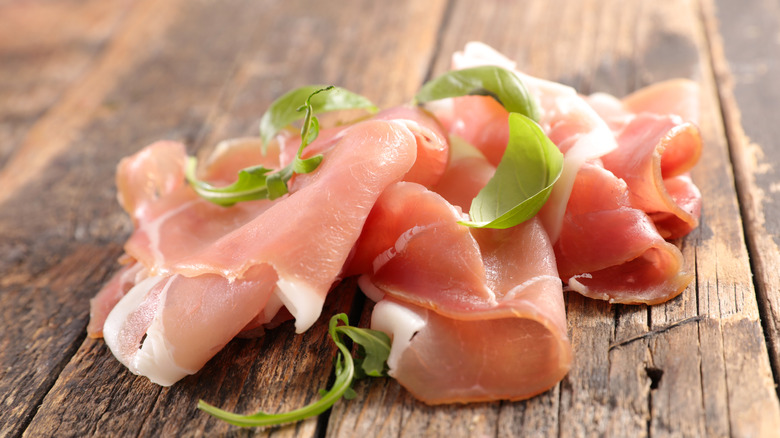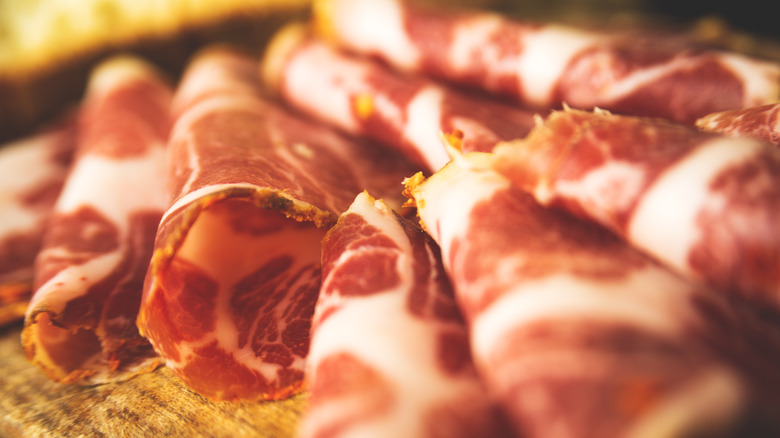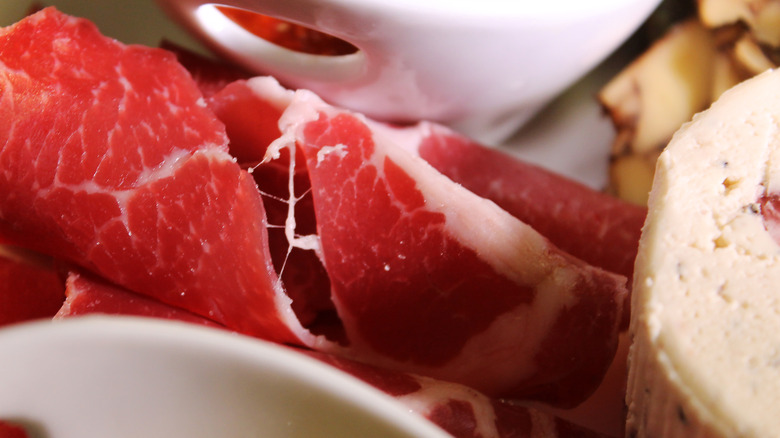The Truth About Capicola
There's no denying that cured meats are delicious. Whether you're piling them on a sandwich or serving them up on a platter, there's just something about them that makes you crave more. But unfortunately, there have been numerous studies on just how bad for you processed meats really are (via Science Direct).
That said, we're here to talk about capicola. It's just one of many types of cured meats, and it's probably one you've heard mentioned a lot on a certain sort of television show. Chances are pretty good you may have heard about it more than you've had it, and it's definitely not a more mainstream sort of cured meat, like bacon. So what, exactly, is it? It is as unhealthy — and delicious — as bacon? What makes it different from all the other types of cured meats out there? Is it as authentically Italian as it seems, or is it just pretending? Let's find out!
What is capicola?
Let's clear up a big one here — what exactly are you eating when you take a bite of capicola? It's actually impressively specific.
We'll start with where it comes from, and according to DePalma Salumi, capicola (or capocollo) is one of a number of types of cured Italian meats. This one comes specifically from the area of the pig between the neck and the fourth or fifth rib of the pork shoulder. That's what the word means, in fact: "capo" means "head" and "collo" means "neck." Academia Barilla gets even more specific and says the pigs of choice are at least eight months old and weigh at least 300 pounds. Traditionally, the best of the best comes from large breeds typically raised in the south of Italy.
In case you're wondering what makes this part of these pigs so special, SBS says it's all because of the fat ratio. Capicola is 30 percent fat and 70 percent lean, and that means it's both tender and moist, even after it's been cured.
Capicola has been around for almost forever
Cured meats are nothing new, and capicola definitely isn't new. According to Academia Barilla, capicola goes back to the era of the colonies of the Magna Graecia... but what does that mean?
For that answer, we'll need to turn to the Ancient History Encyclopedia. The Magna Graecia were areas along the coast of southern Italy that were colonized by the Greeks between the 8th and 5th centuries BC. We did say it's been around a long, long time!
These ancient Greeks were attracted to the area by the particularly fertile lands and its perfect position within a larger trade network, and when they settled there, they made it completely Greek. Not only did they bring things like the Olympic Games, but they also brought stuffed pork sausages. That kicked off the start of the area's deep love of all things pork, and they're still known for their large-breed pigs and their pork products today — including capicola.
Capicola, coppa, capocollo... which one is it?
There are a lot of different terms you've probably heard used to refer to various meats, and a lot of them sound very, very similar to "capicola." Let's clear up any potential confusion with help from DiBruno Bros.
At the root of the confusion is the fact that many regions in Italy have their own version of capicola, and some are very specific just to that area. (Think of champagne — the real stuff only comes from the Champagne region in France, otherwise it's more accurately described as sparkling wine.) For example, Coppa Piacentina involves stuffing the meat into a casing of intestine, and Coppa di Calabria uses wine in the process... and they're both kinds of Italian capicola. The version that's made in America is a little different, though, and it's made with either red pepper or black peppercorn.
Then, there's ham capocollo, which is also called ham-capi and it's also a different thing. That's essentially a spiced and boiled ham, and it's said to be a cross between ham and capicola. Confusing, right?
There are still other types of coppa/capocollo/capicola, says DeLallo. The region of Umbria uses coriander and fennel, while Basilicata traditionally uses hot pepper powder, and their version is typically not as salty or smoky as the stuff from Calabria. The long and short of it is yes, there are different varieties and they come from different regions.
What makes capicola different from other thin, cured meats — like prosciutto?
Cured meats all go through a similar process of washing, salting, and drying... so what makes capicola different from other thin-sliced, cured meats?
Essentially, it's where the meat comes from on the pig that makes it different, says the Huffington Post. Take prosciutto. That comes from the pig's hind leg, and it cures for anywhere from nine months to two years. Speck also comes from the hind leg, but it's made using different spices and it's cold smoked after it's cured. Speck, prosciutto, and capicola can all be used pretty interchangeably, but they're going to taste different and capicola is from an entirely different part of the pig.
What about soppressata? That can come from pretty much any part of the pig, and it can even include "leftover" bits like the head and tongue. Serrano ham? That's Spanish, and it can only be called that if it's from a certain breed of pig, the Landrace. (Similarly, Iberico ham has to come from Iberico pigs.)
Capicola may or may not be cooked
The confusing part isn't over just yet — it's also worth talking about the two different ways capicola is made. Bear with us.
Technically, says The Daring Gourmet, capicola (or capocollo) refers to the thin-sliced neck and shoulder meat that's been cooked. When that piece of neck and shoulder meat is dry-cured, it's more appropriately called coppa... although in the U.S., the terms are often used interchangeably. If you order capicola at your local deli counter, you might just get the dry-cured stuff.
We did say it was confusing!
So, what does it mean when we talk about the process of dry-curing? Again, this is also different based on region and tradition, but essentially, DeLallo says that the process involves taking your piece of meat, adding salt and other spices, then putting into a natural casing, tying it up, and letting it age for at least several months.
And here's why Italy is so good at making these types of meats. According to Academia Barilla, the combination of humidity and temperature found in particular areas of Italy make it perfect for slow aging, as there's little to no risk of the development of mold.
How to make capicola
Capicola might be hard to find, depending on where you live, and it also might be pretty expensive. But there's good news: you can absolutely make it at home.
All you'll need is a pork shoulder, whatever seasonings you like (and since you're doing it at home, there's no need to be traditional), a curing salt mix, and casings. After seasoning your pork shoulder (with the marbling, without the fat cap), there are a few things you can do. You can wrap it tightly in plastic wrap and let it sit in your fridge for a few weeks before putting it into your casing, or you can cover it in salt and let it sit for one day for each two pounds of weight.
Either way, it's the aging process that's the real key here. You'll need somewhere to hang and age your capicola for months before you actually get to cut into it, and you're going to want a place that holds a relatively high humidity but temperatures between 50 and 60 degrees Fahrenheit (via Sausage Maker). Complicated? A bit. A long process? Very. But rewarding? Absolutely.
Why do some people call capicola gabagool?
If you know capicola from The Sopranos or The Office, you probably know it as "gabagool." That's... not even really close to the real word, so where the heck did this come from?
Atlas Obscura says it's because of a weird phenomenon: the development of an accent that's not just regional, but it's specific to the descendents of a group of Italian immigrants. The development of language in Italy is so confusing that even professional linguists aren't sure what the heck happened, and we're definitely not here to argue about linguistics, so we'll talk basics.
Essentially, most Italian immigrants came from different regions in southern Italy, and even when they settled in the U.S., they were still divided into regional groups. And those groups spoke different versions of their native language. When they came together in the U.S., bits and pieces of the languages held on, and formed a sort of Italian-American Italian language.
When that happened, letters started taking on different sounds and inflections. Without getting too complicated, it's all about accents and whether or not a letter's sound comes from your vocal cords or your mouth. The hard "c" in "capicola" became a "g," "p" shifted into a "b." "o" got elongated to "ooh," and — like in so many other words — the last vowel disappeared.
Gabagool.
How to serve capicola
So, here's a question: What the heck do you do with capicola? Sure, you can put it on a platter and serve it just as it is, but that's not all. Capicola is surprisingly versatile, and you can use it for every meal of the day, for a main course, and for appetizers. (Preferably not all in the same day!)
Since it's so thinly sliced, that makes it perfect for making some super-easy, super-elegant bites. Use it to line mini puff pastry nests and cradle a dollop of mashed potatoes, or use it to wrap things like dates and spears of asparagus, or fold them onto crackers and top with a chunk of melon. (Really! The combination is incredible!)
You can also use it to dress up what might otherwise be a pretty boring dinner. Use slices to stuff chicken breasts, or even dice it and sprinkle over your pasta or onto your pizza. For breakfast? How about adding it to your breakfast sandwich or mixing it into your omelet? It'll give whatever you're making an undeniably delicious, super salty kick.
Capicola nutrition
Capicola is delicious and versatile and — perhaps best of all — it's authentically Italian, but you absolutely don't want to go overboard with it, and here's why.
Nutritional information is tough to come by, because there are so many different ways to season and salt capicola. So, for something of a baseline, let's go to Boar's Head, one of the premier companies out there for charcuterie. Their hot, uncured capocollo comes with a serving size of just one ounce, and that includes 590 mg of sodium.
Now, let's put that into perspective. The American Heart Association warns that most Americans get way too much sodium on any average day, and says that ideally, we should be eating no more than 1,500 mg per day. That means that one little ounce of capicola contains more than a third of your daily recommended intake of sodium, and if you have three of those little appetizer bites, you're already over where you should be for the day. And that's a big deal. Too much sodium increases your risk of high blood pressure, heart attack, and stroke, and on average, most Americans already get twice the sodium they should be getting. That makes capicola just as bad for you as it is delicious and, like many things, moderation is key.
Here's why curing capicola makes it safe to eat
Perhaps the most fascinating part of capicola comes from the history of the processes that go into making it. According to BBC, people have been air-curing meat for hundreds (if not thousands) of years. And it's a little weird. You don't want to eat that raw pork chop you pulled out of the fridge, put on the counter, and forgot about when the doorbell rang, right? So why on earth would you want to eat that piece of pork that's been hanging around for months, then sliced into capicola?
It's a fascinating bit of science, and it starts with the salt. Salt kicks off a massive bit of evaporation inside that piece of meat that's eventually going to be capicola, and as the evaporation happens, it turns that piece of meat into a barren, inhospitable wasteland that bacteria can no longer thrive in. There are a lot of factors that play into everything that's going on here — like humidity, temperature, and making sure bugs, beetles, and other nasties stay away from your meat — but yes, thanks to a little bit of science and a lot of human ingenuity, we've perfected the dry-curing process by now. Thanks, ancestors!
There's a few special kinds of capicola
Capicola can be made anywhere, but there's actually a few different types that are extra special. They've been awarded a Protected designation of origin (PDO) status, and that basically means that particular name can only be used if the entire product is made in a particular area or region.
Let's talk specifics. If you buy Capocollo di Calabria, that's a PDO capicola (via QualiGeo). That means you know it came from pigs that were born and raised in the Calabria region of Italy, and that it was made there, too. It's also required to have a layer of fat that's at least three millimeters thick — that helps keep it soft as it ages. There's also Coppa Piacentina, and according to Emilia-Romagna Region Tourism and Commerce, the pigs can be born and raised anywhere in Lombardy or Emilia-Romagna, but the capicola itself needs to be made in Piacenza. And they've been doing it for a long, long time — medieval abbeys feature 12th century murals depicting the so-called "'sacred' ritual of pig slaughter."
Coppa di Parma has a slightly different designation, and that's PGI, or Protected geographical indication. Regulations are a little looser, says the European Commission, and it basically means that the product has a characteristic tied to the region. This particular capicola is made in several provinces, but always uses meat from pigs that are at least nine months old, and are within a 10% weight range of 160 kg.
What does capicola taste like?
Defining what capicola tastes like is difficult because there are so many different methods and varieties that it's entirely possible that you can find one variety you don't like, and another you absolutely love. We can give you a few general guidelines, though.
Most capicola retains a heavy to slight smoky flavor, and DiBruno Bros. – who only carries capicola made in America — says that there are two different types of flavor profiles you might expect. It comes down to whatever spice mixture the maker decides to use, and while there's some wiggle room in specifics, most American capicola is either made with red pepper — which will make it hot and spicy — or with black peppercorns, which will make it more on the sweeter side.
Flavors are so varied that before you pick out a nice-looking side of capicola, you should definitely peek at the ingredients to get an idea of what flavor profile you're looking at. Take some do-it-yourself recipes: While some call for paprika, chipotle powder, juniper, chili powder, and nutmeg, others might call for fennel, anise, red pepper, and coriander to compliment the base of black pepper. Bottom line? There's one out there that's perfect for you!
